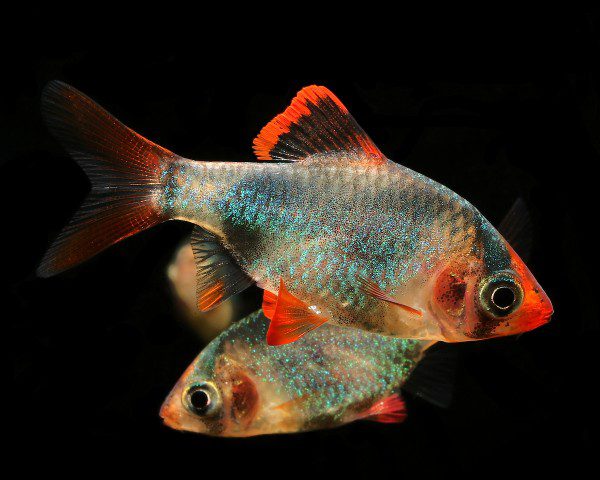
Sumatran barbus – features of maintenance, care and reproduction + photo
Who among aquarists does not know this mobile fish, which loves to always be in a flock? Barbs are not used to living alone, and novice lovers often make the mistake of buying only 2-3 copies. In this case, the rest of the inhabitants of the aquarium may not be greeted, the sumatranus will constantly hurt other fish, up to biting off their fins. But in general, when there are a lot of them, barbs get along quite well with their neighbors and delight the owner with cheerful behavior.
Contents
Description of the Sumatran barb
Once upon a time, ichthyologists attributed barbs to different genera. The beardless were called Puntius, the two-whiskered fish were Capoeta, and the four-whiskered ones were called Barbodes. But back in the XNUMXth century, it was decided not to pay attention to the number of whiskers and, given family ties, to attribute all these fish to the common genus Barbus.
Barbs in the wild live in the fresh waters of Africa and a wide region centered on Southeast Asia. They like the climatic conditions of India, Ceylon, China, Thailand, Indonesia. European inhabitants are also known. Among them are both small ones, those that are kept in aquariums, and very large ones. There are species that grow up to 1,5 m.
The Sumatran barb is native to the islands of Sumatra and Kalimantan. Under natural conditions, it lives in tropical forests, where numerous streams and channels slowly carry their waters. He met Europe in 1935, and appeared in the Soviet Union shortly after the Great Patriotic War. Adult fish usually grow up to 4–5 cm, maximum up to 7 cm. The fish has a rather flat body.
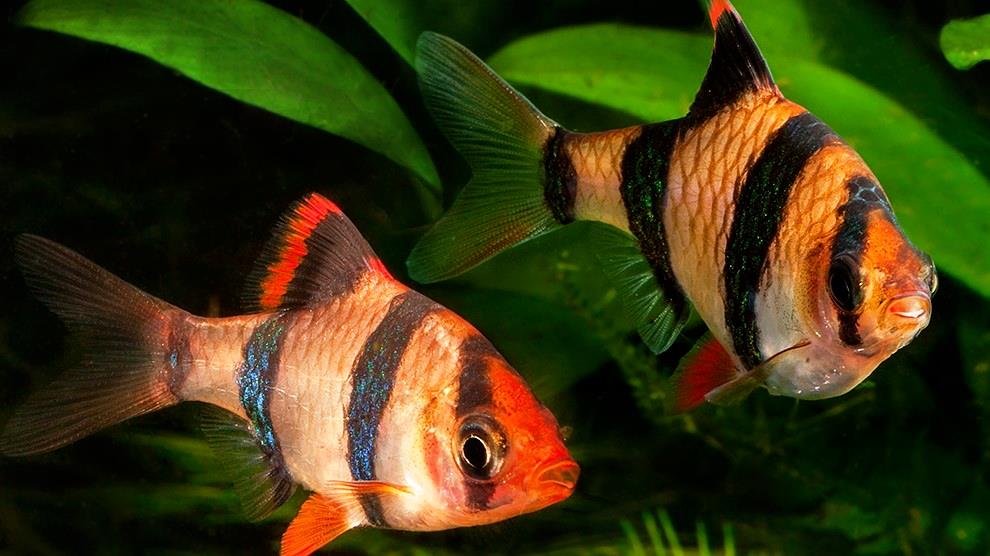
Distinctive features of barbs are four vertical black stripes and red fins.
Barbus is impossible not to recognize. Throughout the almost yellow body from the sides of the Sumatran barb there are four wide vertical black stripes, spaced fairly evenly. The first is through the eyes, and the last is in front of the tail fins. The top of the barb is painted red-brown, the bottom is light yellow with a white tint. The fins are bright red, and only at the very base of the dorsal fin is there a black color.
Most aquarium barbs are fairly peaceful inhabitants. This also applies to the Sumatran barb. They can be settled in common aquariums, but be sure to have a flock of at least 5-6 fish, and preferably about a dozen. In this version, they almost do not pay attention to their neighbors and are content with the company of their relatives. But still, you should not let them into an aquarium with sedentary fish species: they may start bullying them just “for fun”. Especially undesirable is the neighborhood with fish that have veil fins: such fins of barbs are very attractive, they are not averse to biting or tearing off the veil.
It is not difficult to distinguish a male from a female. Mature females of all barbs are thicker, and most males are more brightly colored. The female, ready for spawning, manifests itself as a swelling in the back of the abdomen. In addition, females are just slightly larger than males. This also applies to the gender difference in the case of the Sumatran barb. In the most active males of this species, the part of the body immediately near the mouth is painted in a particularly bright red color.
Video: barbs swim and frolic
Types of Sumatran barbus
In their experiments, breeders got to this striped handsome man: they brought out several forms of the Sumatran barb, not very similar to the original. Among them there are almost colorless fish, and dark green, and even with large fins, almost like a veiltail. The most common are albino and mossy forms.
A change in the basic color of barbs is obtained by various external influences during spawning. This can be a sharp change in temperature conditions, hardness and pH of the water in the spawning tank (spawning aquarium), ultraviolet irradiation of spawned eggs, etc. Unfortunately, modified forms of fish are less adapted to harsh living conditions. Some albinos even manage to live without gill covers (dense skin formations in most fish that cover the gill slits from the outside and limit the gill cavity – the space located between the gills and the inner surface of the gill cover).
Sumatran barbus is an albino
The most common albino barb has a basic pink coloration and bright red eyes. The stripes on the body are present where they should be, they are somewhat darker than the body itself and can be described as red-pink. Albino breeds are also considered golden-colored with a black mouth, steel-colored with pink-gold stripes, etc. One of the forms is called the “golden tiger” or “platinum” barb, in such fish the stripes are completely lighter than the main background. Sometimes the stripes of an albino have a bluish tint. In albino males, during spawning, the anterior part of the body noticeably reddens, mainly the head.
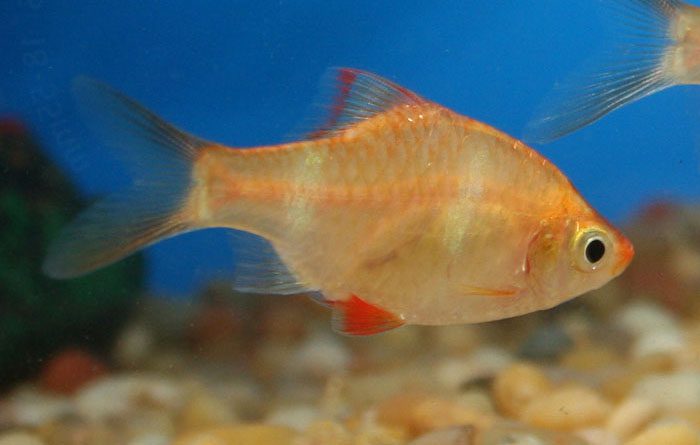
Albino barbs may have a golden color with stripes on the body lighter than the main background.
Sumatran mossy barbus
Mossy barbs have a basic color from green to dark green. It got its name for it: most of all, this shade resembles forest mosses. The main feature of the Sumatran barb in the mossy form is not so striking: the transverse stripes have a color that differs little from the main one, and they are also so wide that they almost merge with each other. The anal fin is almost transparent, the rest are red or orange in different shades. Males also have some red hues on the front and back of the body. By old age, the color of mossy barbs is often paler. Often such barbs are simply called mutants.
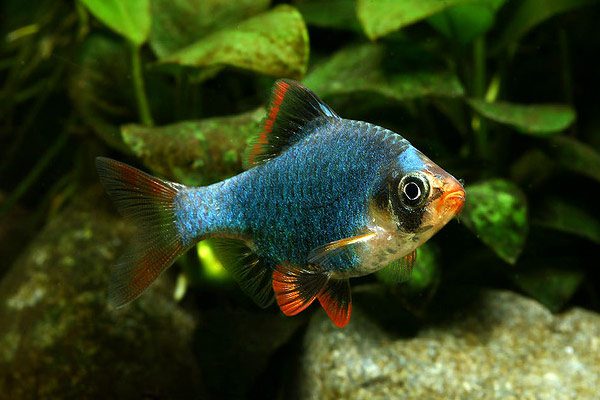
Mossy barb has a beautiful green (dark green) color; the stripes on his body are almost invisible
Features of the content of modified forms
The conditions created in the aquarium for the modified forms of the Sumatran barb are almost the same as those for the parent breed, only it is desirable to raise the temperature by 1–2 degrees, since the fish bred by the breeders are more tender. To maintain the breed during long-term breeding of albinos or mutants, family ties should be periodically canceled, i.e., a female or male should be replaced with a “stranger” during spawning. Well, if this stranger is from ordinary sumatranus: yellow and with black stripes, this is how they achieve stronger offspring.
Fry of altered forms need to be fed more often and more. You should not expect only albinos in the offspring of albinos, and only mutants in mutants. The theory of genetics does not allow this, up to a quarter of the kids will be ordinary sumatranuses. Only by crossing males and females from the same litter, you can expect an almost complete brood of fry, similar to the parents. But you should not do this: the viability of fish from the next of kin is much lower.
Keeping and caring for Sumatran barbs in an aquarium
The conditions for keeping barbs are the most common, they differ little from the conditions for keeping a good half of aquarium fish.
Aquarium environment conditions
Keeping a Sumatran barb at home is quite simple. Of course, these are not guppies, with the acquisition of which almost every novice aquarist begins.
Requirements for living conditions, feeding, even for spawning in sumatranus are common, like in most representatives of the barb genus. Since they are distinguished by extraordinary mobility, they must be provided with sufficient volume for walks and fun games. You need an aquarium no less than a 5-bucket, the ratio of length to height is up to you. It is better, of course, that it be elongated, there was where the flock would scatter.
In a 5-liter jar, Sumatran barbs will live, but from a lack of movement they will swim in fat and refuse to breed. Banks in matters of aquaristics should generally be banned: even children from an early age should be told that everything should be done according to the rules.
The optimum water temperature is 21-23 ° C, more than 25 ° C is already undesirable. As with most fish, about 20-25% of the water should be replaced with fresh, well-settled water once a week. They prefer soft and slightly acidic water (pH — from 6,5 to 7,0), but you don’t have to worry about this: they transfer any ordinary one from the city water supply. It is clear that settled and with a steady balance, but here we are not considering the basics of the aquarium business.
The best soil is coarse-grained sand of dark shades, in which many plants are planted, including those that will not be a pity: barbs love to eat their soft leaves. Therefore, a kabomba, for example, is guaranteed to have a not very “marketable” appearance. Most of the time barbs spend in the middle layers of water.
Regarding forced aeration (artificial air saturation), in the case of keeping barbs, nothing special is required: with a dense landing of fish, a compressor (a device for compressing and supplying any gas under pressure) is definitely needed. But if the aquarium is free and light, the oxygen produced by the plants should be sufficient. The same applies to the issue of filtration: in case of overcrowding, the water will quickly become cloudy, and then one cannot do without a filter (and hence air blowing). If you have up to half a bucket of water for each individual, extra equipment may not be required. After all, we must remember the conditions of the natural habitat of these fish: they do not like a strong current, which is often created by powerful filters.
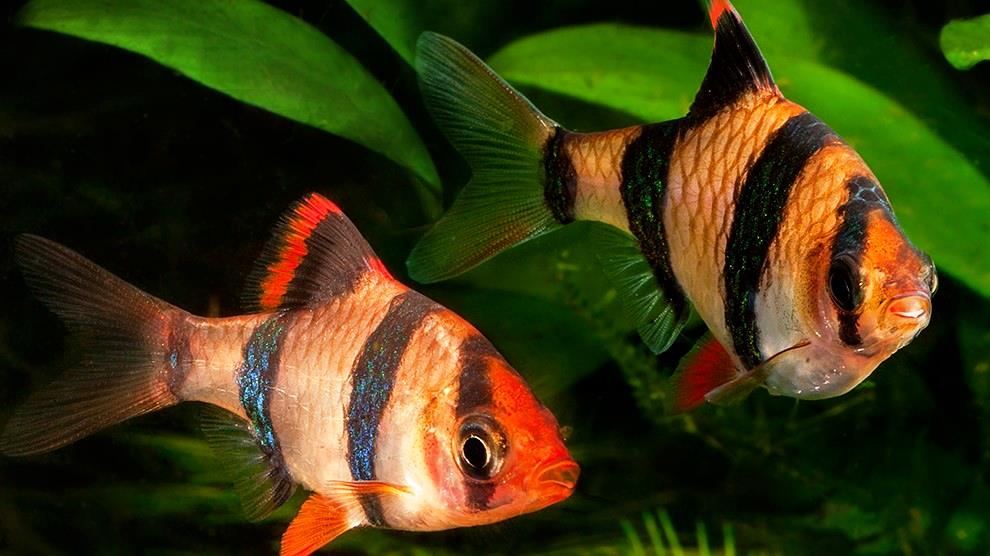
Sumatran barbs should have plenty of room to play
The issue of lighting is also not the most important. Almost always, a home aquarium is lit from above. The amount of light needed depends more on green inhabitants than on floating ones: plants need light badly. It is desirable for the barbs themselves to create both light zones and zones shaded by floating plants, for example, Riccia (by the way, another vitamin supplement!).
Feeding
Barbs eat everything or almost everything. Any live food that is suitable in size (small bloodworm, tubifex, coretra, daphnia, etc.), the minke whale will swallow with pleasure. All known dry food is also suitable for him. And even bread, which is usually not advised to feed aquarium fish, the barbus eats “for both cheeks.”
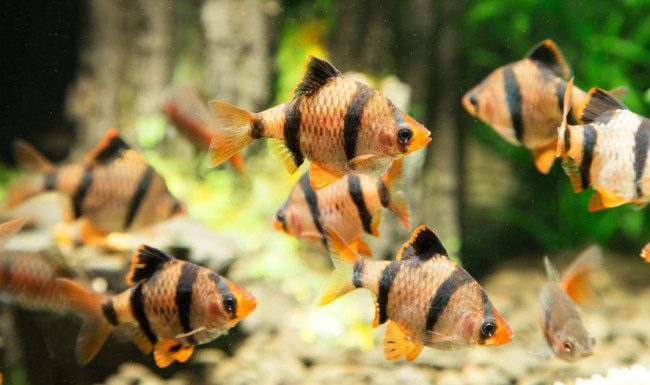
Bloodworms are a favorite treat for most aquarium fish.
Walking around the aquarium, the flock constantly pinches something on the plants: it collects the smallest algae. Plant food is also necessary for these fish, especially females in preparation for spawning. The addition of plant-based foods, such as regular chopped lettuce, helps prevent obesity, especially in small aquariums.
Barbs will find food anywhere, although they love the middle layers of water most of all. But they will pick up a dry gammarus on the surface, and a tubifex trying to burrow into the ground will also be pulled out of it. For these fish, the principle is especially important: “It is better to underfeed than overfeed.” Feed should be given so much that their breakfast or dinner (and lunch is not needed) fits in a few minutes. And once a week it is better not to give anything at all: they will clean the aquarium and not get fat.
Compatible with other aquarium fish
Sumatran barbs can be kept with most peaceful fish. Few people will harm them, but they themselves can “not out of evil” do trouble, especially if there are only a few of them themselves, but you want to play with someone. Often they take damage or even biting off the fins of sedentary fish as an element of the game, especially if these fins flutter in the water column. Therefore, veil-tailed guppies, young representatives of most breeds of goldfish and even gourami often suffer from these striped robbers.
An interesting situation can arise if Sumatran barbs are settled along with butterfly fish (the official name is ramiresi apistogram). The fact is that the body of the butterfly itself somewhat resembles the body of the sumatranus both in flat shape and in color (yellowish background with dark vertical stripes). But the most popular form of ramirezi apistogram has chic huge fins, of course, very attractive for aquarium robbers.
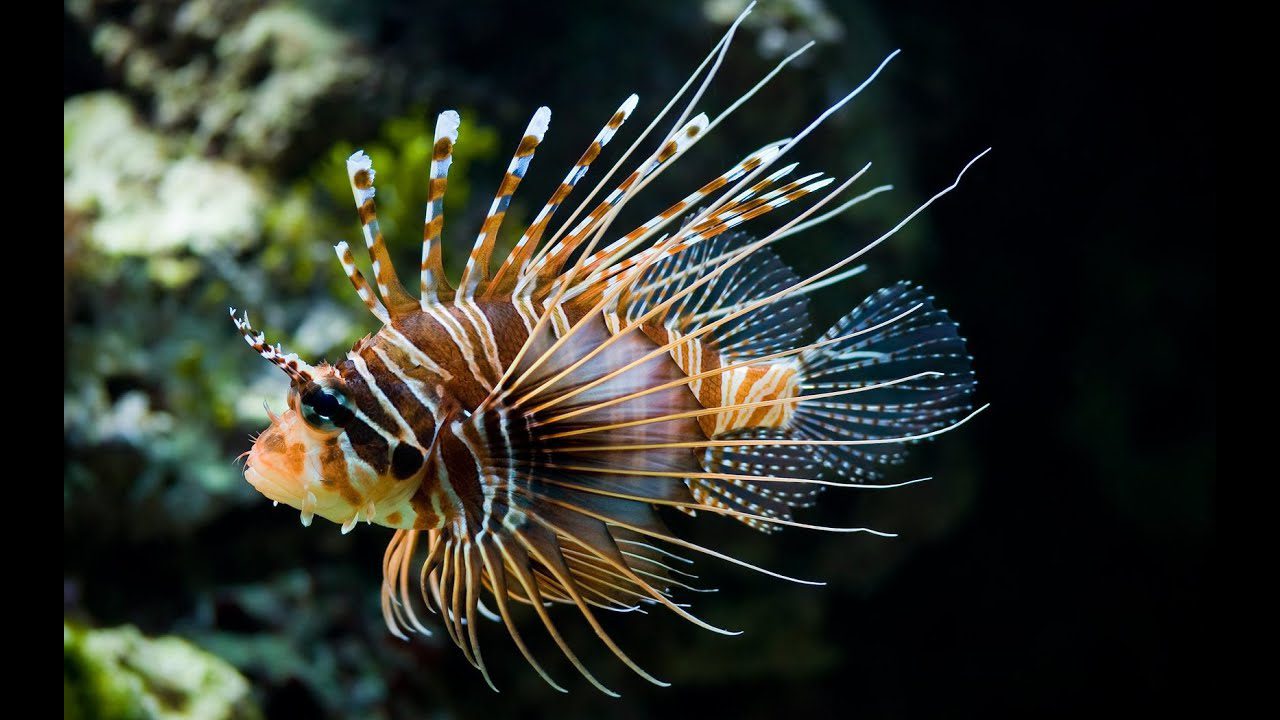
Apistogramma ramirezi may suffer from the antics of the Sumatran barb
The butterfly fish itself is exceptionally peaceful and even trusting. So these nimble bandits can bite her. But ramirezi often lives near the bottom and will rarely intersect with barbs. Therefore, there may be several options for the coexistence of these fish, and you should not listen to the first adviser in this matter. It is necessary to weigh everything and decide: after all, the optimal conditions for keeping cichlids (to which the ramirezi apistogram belongs) and barbs are not exactly the same! Probably, if the aquarium is very spacious, and the fish live in it from a young age, then there should not be any special problems. But if barbs already feel like masters in a small aquarium, then planting a ramirezka there will be very reckless.
Breeding Sumatran barbs
The life expectancy of barbs in an aquarium is a maximum of 5 years. Sexual maturity in ideal conditions of detention occurs after six months (sometimes up to 10–12 months), but males can be distinguished by their brighter coloration (mainly fins) already at the age of 3–4 months.
Breeding barbs is available even to a novice amateur. It happens that these fish spawn even in a common aquarium, not paying attention to their neighbors. Of course, in this case, there is no need to wait for offspring: caviar will certainly be eaten by a variety of aquatic inhabitants. For successful breeding of sumatranus, you need a small separate aquarium with a capacity of 10–20 liters.
Selection of manufacturers
Sumatran barbs, when properly maintained, are capable of breeding from 7–8 months, but their preparation for this process should begin much earlier. As soon as sexual differences in juveniles are visible, the most brightly colored, medium-sized and mobile fish are selected and kept at a temperature not higher than 20-22 ° C, giving food only 1 time per day. The food should be varied (not necessarily only live!). As in ordinary life, barbs should be given food containing various nutrients, which means that algae and lettuce (and even chopped nettles) are needed, and sometimes scalded semolina should also be given. Specialists even feed males with microdoses of vitamin E.
The female is not so bright, and the caviar in the abdomen does not make a mistake that the female is in front of you
Intended parents, selected after being kept under the described conditions, are seated in separate aquariums 2-4 weeks before being placed for spawning and the temperature is reduced by a couple of degrees. They continue to feed only once a day, but in the last month they are limited to live food (small bloodworms, daphnia, coretra). The main thing in feeding now is to prevent future producers from becoming obese.
For spawning choose the best pair. A female ready for spawning should have a swelling in the back of the abdomen, and not in the front. The optimal choice of a male is brightly colored, nimble. Well, if a couple of months older than the female. Sometimes, for reliability, two males are taken per female.
Preparing the aquarium for spawning and spawning
An aquarium for spawning barbs should be spacious enough: at least a bucket, preferably one and a half to two, elongated. It is desirable to take water that is softer than in the previous dwelling, since in the wild spawning of barbs usually occurs during the rainy months. You can simply add to the commonly used 25 percent distilled, in extreme cases, boiled water. Aeration should be arranged, but with a small pressure and with a fine spray. The water temperature in the spawning area is maintained at 28–29 °С. It is not necessary to add soil, but it is advisable to place any plastic mesh with cells of several centimeters 2-3 cm from the bottom so that the eggs fall to the bottom through it, but are not available for eating by parents. True, the caviar is so sticky that part of it will stick to this mesh, but you don’t need much, the female spawns up to 600 yellowish-green eggs! To make the fish feel comfortable, there should be at least some plants in the spawning ground. Many simply cover the bottom with small-leaved species, but this is much worse than the mesh prevents eating caviar. Therefore, it is better to simply place a bunch of Javanese moss in the corner of the aquarium just to stimulate spawning.
The female is placed first in the spawning ground, and only a day later, in the evening, a male or two males are placed. If it is necessary to simultaneously place the producers, do this in the morning, and only after that the temperature is gradually raised. But this is not the best option, because sumatranuses do not think about what is happening for long (no more than a day) and finally decide to spawn. And since this happens almost always in the morning, it is optimal to let the male to the female in the evening. Of course, they are not fed there!
If the aquarium is located on the sunny side, there is usually enough light, especially bright light is not required. But for insurance in the morning, it’s worth lighting at least a table lamp nearby. This is the signal for spawning, which will last for a maximum of 2-3 hours.
After spawning, the producers must be immediately landed. The net is also removed, shaking off the eggs that have settled on it, the aquarium is darkened for a day. Immediately after this, a third of the water is changed to soft fresh, and a little methylene blue solution is added for disinfection (up to a barely noticeable blue color). In this case, it is better to lower the water level to about 10 cm. The compressor should be turned on a little more.
By evening, it is already easy to see the unfertilized dead eggs. If there is a lot of such whitened caviar, you can try to remove it.
Video: barbs spawn
Fry care
Usually the first barely noticeable larvae hatch from the eggs in a day. After a few more days, they use up the entire supply of nutrients that was in the yolk sac (the embryonic or larval organ, inside which there is a supply of yolk used by the embryo or larva for nutrition). They become fry, begin to swim and are very hungry. Now the temperature can be gradually lowered: in a month it should be about 24 ° C.
First, they are fed for a couple of days with infusoria, then with “live dust”, boiled egg yolk, Artemia nauplii (crustacean larvae). Nowadays, you can also use special dry food sold in pet stores. You need to feed often, but little by little. Since the food will still remain and begin to rot, the water should be refreshed almost daily. A pair of young snails, ampullaria, put into it will help in cleaning the aquarium of any residue.
In a week, the fry will already begin to eat small cyclops (crustaceans), after two, you can give a chopped tubifex. As the fry grow, the food must be enlarged, and the offspring themselves sorted by size. The fact is that the fry grow unevenly, and the time comes when the largest ones begin to attack brothers and sisters. At the age of one month, the fry already look like adult barbs.
Video: life and reproduction of the Sumatran barb in an aquarium
Diseases of the Sumatran barb and ways to deal with ailments
With the right content of health problems in fish does not occur. But when deviating from the rules, barbs, like any aquarium fish, easily pick up external infections. There are hundreds of diseases of aquarium fish, it is impossible to consider everything within the framework of this article, so it is worth dwelling on the most common ailments. Fortunately, most of them are treated with the same drugs. For example, Bicillin-5, Biomycin and other antibiotics are suitable for parasites. Dyes often help: Basic violet K, Malachite green, Methylene blue. In the simplest cases, bathing in a solution of table salt or a pale pink solution of potassium permanganate also helps.
All fish diseases are divided into contagious (caused by viruses, bacteria, fungi and various parasites) and non-contagious (for example, congenital pathologies or poisoning due to poor ecology). In general, sumatranus are distinguished by excellent health and rarely get sick. The most frequent ailments they have are associated with “character”: they often simply overeat. To treat such cases is simple – hunger and only hunger. However, barbs, like any aquarium inhabitants, sometimes get sick with infectious diseases, but it is very difficult for a simple lover without a specialist to make a correct diagnosis in this case.
Any white spots on the body of the fish mean that protozoan parasites have settled in it. The common name for such a disease is ichthyophthiriosis (literally – fish louse), almost all types of fish are affected by it. The cycle of protozoa in an aquarium is easy, and getting rid of parasites is not an easy task. If white spots have formed on the head, closer to the nose, and are converted into ulcers, then most likely the fish is sick with hexamitosis, another parasitic disease. Sometimes in the treatment of both, simply increasing the temperature of the water and changing it frequently help, but special agents, such as Miconazole or Tripaflavin, also have to be used. But they begin to fight with bathing pets in a solution of table salt (3-5 g / l).
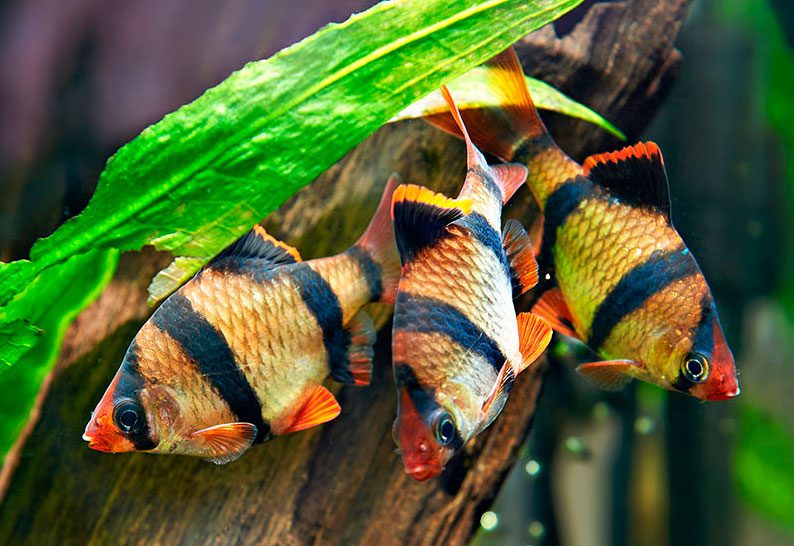
White spots on the body of the Sumatran barb indicate the presence of parasites in its body.
There are symptoms by which it is simply impossible for an amateur to determine the disease. For example, if a fish assumes unnatural postures, rolls over, hangs upside down or upside down, it is even difficult to understand whether this disease is contagious or non-contagious. It can be anything from a simple swim bladder imbalance or chlorine poisoning from unsettled water to infection with gill worms.
Most often, with poor care, barbs become ill with fin rot and ichthyophthiriosis, as well as rubella. An ailment characteristic mainly of barbs is gill rot. It destroys the gills, causing the death of fish from a lack of oxygen.
There can be many causes for fin rot, but fortunately it can almost always be cured with simple treatments like hydrogen peroxide.
If it is fin rot (and it looks like it), it can be cured
Rubella healthy fish become infected through contact with sick animals. The incubation period is 5 days, after which the body of the fish becomes covered with spots. Often the disease is accompanied by bulging eyes or abdominal dropsy. They are treated with antibiotics and sulfanilamide preparations (Sulfanilamide at a dose of 100 mg/l, Biomycin or Erycycline 50 mg/l, etc.) for 5–10 days. Recovered fish acquire immunity, but are carriers of rubella.
In fish infected with white-skinned, damage to the organs of the nervous system is observed. The main symptom of the disease is pallor of the skin of the upper and back parts of the body. It is treated with drugs containing active chlorine or copper sulfate, as well as Minocycline or Biomycin. The aquarium must be thoroughly disinfected.
Gill rot disease affects the circulatory system of the gills and leads to their disintegration. Sick fish stop eating, stay on the surface, itch on the ground. Treatment is carried out with the help of Rivanol, Nystatin and Griseofulvin for a week or two.
Details of fish diseases and methods of their treatment are described in the special literature.
Table: bacterial diseases of fish
The main fungal and viral diseases and methods of their treatment are summarized in the following table.
The following table presents the main diseases caused by parasites, both microscopic and rather large worms.
Table: parasitic diseases of fish
Finally, the table below shows examples of diseases caused by injuries or various poisonings, that is, non-contagious ailments.
Table: results of injuries or incorrect conditions for keeping fish
The Sumatran barb is one of the most interesting aquarium fish with a cheerful disposition and playful character. Keeping barbs in captivity is not difficult. The process of breeding them is also simple. It is a must to have these cute minke whales in your home aquarium.





